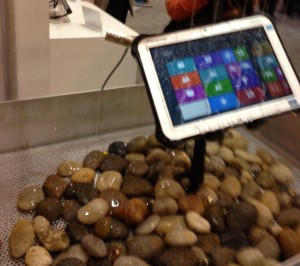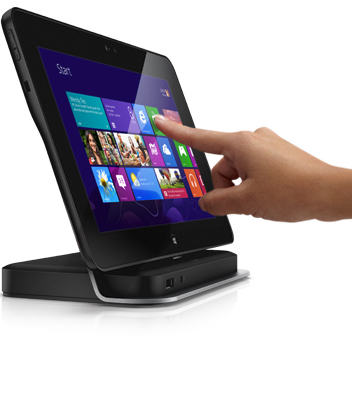
Panasonic's ToughPad was subjected to a shower of water at HIMSS 2013.
One of the media narratives that came out of CES this year, was that despite not attending the show, as is its custom, Apple managed to have a significant effect on the proceedings. The same thing could be said of HIMSS, especially when it comes to tablets, where Apple's absence was keenly felt in the midst of so many competitors. And while Microsoft was staunchly promoting their new Surface Pro tablet, most devices on display were not competing consumer devices, but rugged, dedicated "medical-grade" enterprise tablets.
With the overwhelming popularity of iPads and iPad Minis among tablet-using physicians, it's easy to forget that the history of the medical tablet long predates Apple's entry into the field. Companies like Motion Computing were making medical tablets in 2001, but for a number of reasons, adoption has been slow.
"Half of the sales cycle was convincing them they needed a tablet," Kyle Sale, Director of Product Marketing at Motion Computing told MobiHealthNews during an interview at HIMSS13. "And the iPad came along and broke down that barrier for us, but it began to present a challenge. People use their iPads at home and think, this is really cool. I'd like to use this at work."
But according to the medical tablet makers, a good consumer device is not always a good enterprise device, and for all the panache of the iPad, they argue that it is inadequate for clinical workflows. Sale said that more than once the company has lost out to Apple on a sale, only to have the CIOs come back with a changed tune.
"Ninety days later they call us back and say we just deployed 30 as a pilot, it's not working," he said.
Motion has a forthcoming report that puts the net cost of using consumer devices in an enterprise setting at four or five times the cost of using dedicated enterprise devices, Sale said. Similarly, Dell recently commissioned a detailed report from Principled Technologies which found that over three years, deploying Dell's Latitude 10 tablet was 60 percent cheaper and 11 times faster than deploying Apple devices.
"Apple has made it very clear that they are not customizing their platform for business," Dell's Chief Medical Officer Dr. Andrew Litt told MobiHealthNews. "If people want to use them in business environments that's fine. Our focus is on the enterprise -- how do you make an It implementation of 250 or 500 devices cost effective over time? It's not about who's cheaper to buy at the moment. Frankly, they're all about the same. It's about what's cheaper over three years."
Advantages to a dedicated enterprise device

Dell Lattitude 10 tablet
The most obvious selling point to dedicated medical tablets is ruggedness. Panasonic's Toughbook and Toughpad units symbolize this well -- the company displayed the devices under a running stream of water at HIMSS.
"[Our tablets] all came about because customers said, we like the form factor, but it doesn't really work from a reliability, security, sanitizablility context in our environment," said Kyp Walls, Director of Product Management at Panasonic. "Everybody working outside of an administrative category needs something rugged. If clinicians are worrying about equipment and not their patients, they're less effective."
Medical tablet makers usually offer a range of devices with different degrees of toughness, at a trade-off for weight and ease of use. An EMT might need the most rugged book, while an internist might need less.
Hand in hand with ruggedness is sterilization -- most medical tablets can be washed, rubbed down, heated, or cooled, depending on the hospital's procedures, so it can be taken in and out of clean rooms.
An even bigger sticking point is battery life, an area where almost every medical tablet maker pushes the sale.
"A lot of shifts are 12 hours now," said Dell's Litt. "Well, if you have an 8-hour battery, what do you do at the end of eight hours when your iPad dies?"
Dell's Latitude 10 tablet has an optional 20-hour battery or a standard 9-hour battery. More to the point, the battery is swappable, with a built-in backup that kicks in during the swap.
Finally, multiple options for screen-size, from Motorola's 7-inch ET1 tablet up through Panasonic's 20-inch high definition 4K tablet, help optimize medical tablets for a range of use cases. Smaller devices fit in pockets and are easy to carry, but large devices are favored by specialists like radiologists, who need to display a lot of medical images in easy-to-read ways.
A final area where tablet makers -- and in this case Microsoft's Surface is also included -- see a chink in Apple's armor is input devices. The iPad really only has touch input. Most medical tablets also have a stylus (often from artist tablet maker Wacom) that allows for e-signatures on consent forms and perceptions. Some can also dock into keyboards.
Fujitsu's tablets have a simple rubber webbing in the back to make the tablet easier to use one-handed.
Sale, from Motion, says the difference is more than the sum of the features. It's the mentality of meeting providers where they are.
"We tout ourselves as a solutions provider. We try to never have a tablet sitting by itself. They're connected to vehicle docks that would mount into an ambulance or fire truck. Or they're at a nursing station, with fresh batteries always on standby," Sale said. "We really try to think about the day in the life of the user."
Operating Systems are a key consideration
Apple is somewhat proprietary about their OS and their devices, and that leads to trouble for CIOs. It's a challenge to update software on a large number of Apple devices, for instance. And if an iPad has a serious hardware problem there's no real recourse but to send it back to Apple.
Dedicated medical tablets are mostly built by hardware companies who turn to partnerships for the software. And, at least at HIMSS, there were basically two games in town: Android and Windows 8.
Windows 8 was popular among device makers at the event, running on Dell, Fujitsu, and Motion's devices as well on one Panasonic tablet. Panasonic and Motorola are in the Android camp, although Motorola's Dino Gregoritch told MobiHealthNews the company is moving back toward Microsoft. He said they worked with them previously, but they seemed to have given up on tablet operating systems prior to the Windows 8 release.
"When Microsoft stepped back, Android was there," he said.
"The iPad is a fantastic device for consuming content, media," said Mike Wright, a Staff Systems Engineer at Fujitsu. "The Windows-based tablets are for getting Windows work done."
Windows 8 has a few things going for it. Microsoft designed the operating system to be active across desktop, tablet, and smartphone form factors, which means it adapts well to the various screen sizes of different devices. A number of EHRs have recently announced Windows 8 versions, and the operating system was designed with HIPAA in mind as well.
Android is reportedly more complicated to port to different form factors, and there's a lower level of confidence in security. Gregoritch said that Motorola is developing much of their tablet software in HTML5, in the hopes of being "operating system agnostic."
Several of Microsoft's partners -- the company boasts 1,500 devices running the OS -- admitted to being taken aback when the company released the Surface, its own tablet hardware, making it a competitor to so many longtime partners.
"Microsoft has ruffled the feathers of their OEM partners by launching their own hardware, but that hardware is very much focused on the consumer," said Motion Computing's Sale.
Microsoft's Dennis Schmuland said his company still values those partnerships.
"It's something we're concerned about all the time. We want to build in new innovations and then make them available to our partners," he said. "The best analogy to think about is, when we produced the Kinect for Xbox, we produced games just to show what was possible, and then in turn we continued to work with all of our partners."
BYOD: End users vs CIOs
Despite all the value medical tablet makers say the device adds over the iPad, the iPad's continued success in healthcare speaks for itself. Doctors love the iPad.
Interestingly, medical tablet makers aren't trying to fight doctors on that, on a consumer level. Medical tablet makers sell enterprise devices to hospitals, to be used by physicians and nurses at work only.
The problem, enterprise tablet makers say, is that physician consumers love their devices, love the productivity they add, and want to use them at work. But the lack of enterprise features makes it hard for hospital CIOs to manage them. Litt, from Dell, predicted that the BYOD pendulum might swing back the other way, however.
"Most organizations will end up with a dual policy, we will support BYOD in a limited way with very strict rules. People will complain, but people complain about washing hands. That's the right thing to do," Litt said. "The right solution will be an enterprise level solution."
It's clear that most medical tablet vendors are going after care providers, and not consumers, in their sales, but an effort is still in place to make sure the devices are intuitive, fun, and easy to use. Once providers are handed the device, many of the tablet makers said they like it as much as their iPad. With the help of frazzled IT departments, enterprise medical tablets might well be making a comeback. But whether they'll ever take the place of the iPad in doctors' hearts is anyone's guess.
MobiHealthNews coverage of the HIMSS13 event in New Orleans is sponsored by AirStrip Technologies.


















